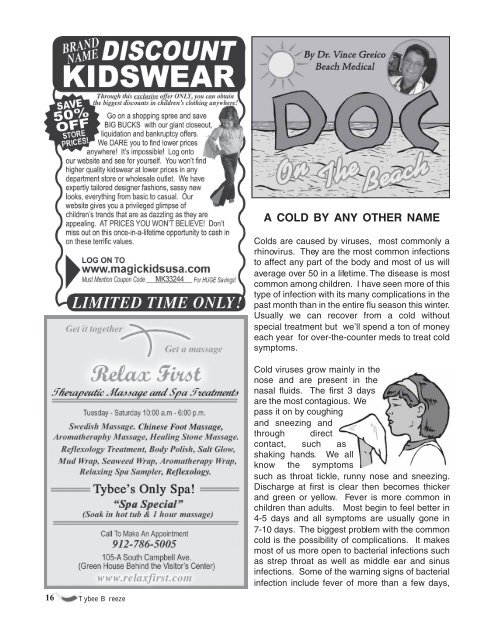Tybee Breeze
Tybee Breeze
Tybee Breeze
You also want an ePaper? Increase the reach of your titles
YUMPU automatically turns print PDFs into web optimized ePapers that Google loves.
16<br />
<strong>Tybee</strong> <strong>Breeze</strong><br />
A COLD BY ANY OTHER NAME<br />
Colds are caused by viruses, most commonly a<br />
rhinovirus. They are the most common infections<br />
to affect any part of the body and most of us will<br />
average over 50 in a lifetime. The disease is most<br />
common among children. I have seen more of this<br />
type of infection with its many complications in the<br />
past month than in the entire flu season this winter.<br />
Usually we can recover from a cold without<br />
special treatment but we’ll spend a ton of money<br />
each year for over-the-counter meds to treat cold<br />
symptoms.<br />
Cold viruses grow mainly in the<br />
nose and are present in the<br />
nasal fluids. The first 3 days<br />
are the most contagious. We<br />
pass it on by coughing<br />
and sneezing and<br />
through direct<br />
contact, such as<br />
shaking hands. We all<br />
know the symptoms<br />
such as throat tickle, runny nose and sneezing.<br />
Discharge at first is clear then becomes thicker<br />
and green or yellow. Fever is more common in<br />
children than adults. Most begin to feel better in<br />
4-5 days and all symptoms are usually gone in<br />
7-10 days. The biggest problem with the common<br />
cold is the possibility of complications. It makes<br />
most of us more open to bacterial infections such<br />
as strep throat as well as middle ear and sinus<br />
infections. Some of the warning signs of bacterial<br />
infection include fever of more than a few days,




